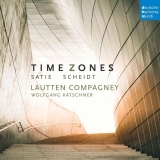 Time Zones; Samuel Scheidt: Ludi musici I Nr. 9, 11, 17, 22-24 + Canzon ad imitationem Bergamasca SSWV 64 + Herr, wie lang wiltu mein sogar vergessen SSWV 1 + Miserere mei Deus SSWV 223 + Laudate Dominum in sanctis SWWV 72 Nr. 4, 5, 8 + Symphonie aus dem C SSWV 379 + Symphonie aus dem A SSWV 439 + Symphonien aus dem g-Moll SSWV 416 & 417; Erik Satie: Pièces froides Nr. 1-3 + Gymnopédie Nr. 3 + Sarabande Nr. 3 + Gnossienne Nr. 4 + Avant-dernières pensées + Descriptions automatiques + Les Oiseaux + Sonatine bureaucratique; Paul Dessau: Air aus Suite für Saxophon & Klavier arrangiert für Barockensemble; Erwin Schulhoff: Fuga aus Bassnachtigal op. 38: Lautten Compagney, Wolfgang Katschner; 1 CD Deutsche Harmonia Mundi 19439807052; Aufnahme 08/2020, Veröffentlichung 11/2020 (70'34) -Rezension von Norbert Tischer
Time Zones; Samuel Scheidt: Ludi musici I Nr. 9, 11, 17, 22-24 + Canzon ad imitationem Bergamasca SSWV 64 + Herr, wie lang wiltu mein sogar vergessen SSWV 1 + Miserere mei Deus SSWV 223 + Laudate Dominum in sanctis SWWV 72 Nr. 4, 5, 8 + Symphonie aus dem C SSWV 379 + Symphonie aus dem A SSWV 439 + Symphonien aus dem g-Moll SSWV 416 & 417; Erik Satie: Pièces froides Nr. 1-3 + Gymnopédie Nr. 3 + Sarabande Nr. 3 + Gnossienne Nr. 4 + Avant-dernières pensées + Descriptions automatiques + Les Oiseaux + Sonatine bureaucratique; Paul Dessau: Air aus Suite für Saxophon & Klavier arrangiert für Barockensemble; Erwin Schulhoff: Fuga aus Bassnachtigal op. 38: Lautten Compagney, Wolfgang Katschner; 1 CD Deutsche Harmonia Mundi 19439807052; Aufnahme 08/2020, Veröffentlichung 11/2020 (70'34) -Rezension von Norbert Tischer

Die Berliner Lautten Compagney sorgt erneut mit einem ungewöhnlichen Programm für Aufmerksamkeit. Time Zones verbindet Musik des deutschen Frühbarockkomponisten Samuel Scheidt (1587-1654) mit bearbeiteten Klavierwerken des Franzosen Erik Satie (1866-1925), sowie von Paul Dessau (1894-1979) und Erwin Schulhoff (1894-1942). Im historischen Instrumentarium mit u.a. Streichern, Blockflöten, Zink, Posaune und Laute bringt das Saxophon eine zusätzliche Farbe.
Die Kompositionen wurden von Bo Wiget und Wolfgang Katschner für die spezielle instrumentale Besetzung der Lautten Compagney arrangiert.
Während die fein und vital musizierten Scheidt-Kompositionen auf dem üblich hohen Niveau der Lautten Compagney gespielt werden, faszinieren vor allem die Satie-Stücke, deren neues Kleid sie besonders chic werden lässt. Die typischen Satie-Stimmungen werden dabei mit neuen Farben verstärkt. In diesem Fall bringen die Bearbeitungen also durchaus Mehrwert.
The Berlin Lautten Compagney once again attracts attention with an unusual programme. Time Zones combines music by the German early baroque composer Samuel Scheidt (1587-1654) with arranged piano works by the Frenchman Erik Satie (1866-1925), as well as by Paul Dessau (1894-1979) and Erwin Schulhoff (1894-1942). The saxophone adds an extra colour to the historical instrumentation, which includes strings, recorders, zinc, trombone and lute.
The compositions were arranged by Bo Wiget and Wolfgang Katschner for the special instrumentation of the Lautten Compagney.
While the Scheidt compositions are finely and vitally performed at the usual high level of the Lautten Compagney, the Satie pieces are particularly fascinating, since their new ‘dress’ makes them particularly chic. The typical Satie moods are enhanced with new colours. In this case, the adaptations definitely bring added value.
























